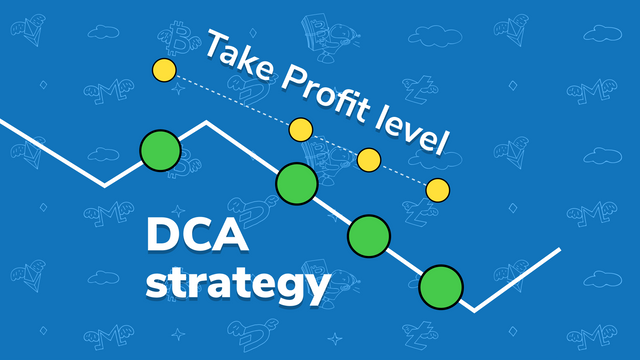What is dollar-cost averaging (DCA)?

Dollar-cost averaging (DCA) is an investment strategy that involves investing a fixed amount of money regularly no matter what is occurring in the financial markets.
Further, you will see how it works.
How to apply DCA in traditional trading
Usually while implementing DCA, investors divide the total amount of funds they invest in the purchase of the target asset, to reduce the impact of volatility on the overall investment.
But why can't we immediately invest a lump sum of money?
The thing is that when the share’s value soars, your money will buy fewer shares per dollar invested. When the share price drops, your money will get you more shares.
Have a look at the example.
Imagine you invest $1000 in the Tesla stock monthly for four months in a row. In January, the price of the shares plunges to $500 each, therefore you buy two Teslas; in February, March and April the stock costs $250, so you buy four. In total, you acquire 14 stocks at $285 each. Thus, if you had spent all the money in January, you would have bought only 8 shares for $500 each.
Automation of the DCA strategy with crypto bots
If you are familiar with TradeSanta bots, you might be aware of short and long bots that use averaging as a mechanism to enhance your profits and minimise your losses.
For instance, you buy one Bitcoin worth $10K and set the take-profit target at 20% to gain profit from the deal. However, the price is starting to decline to $9K, then $8K and eventually to $6K.
At this point, you’re probably wandering around your room nervously trying to see whether your order will be ever completed. Alas, the answer is “no” because the value didn’t reach $12K.
Nevertheless, with the DCA bot, you will still get a profit. You just use three extra orders to average the take-profit target and then distribute the investment over a longer period. Thus, when the price sinks to $9K, the bot will place the buy order. After adding two prices, $10K and $9K, we’ll invest $19K, meaning our 20% take-profit target will make $3800. Once the first extra order is executed, the trading bot will try to sell two of your Bitcoins for $11400 each. In other words, ($19K + $3800) divided by two will make $11400.
But what should you do if no one wants to buy the coins because their price continues to fall below $8K?
When the coin’s value hits $8K, you buy one more BTC and have $27K spent in total. Again, your 20% take-profit target will be recalculated, reaching $5400. So the DCA bot will attempt to sell three of your coins for $10800 each. ( $27K + $5400) divided by 3 will return $10800.
This example clearly illustrates the benefits of dollar-cost averaging, especially during periods of volatile share prices. Instead of buying three Bitcoins for $10K each, you have bought three for the average price of $9K and made a profit.
Conclusion
In the long run, DCA is a highly strategic way to invest that is also used to automate your trading processes. However, do not forget that crypto bots can only implement your knowledge and experience. Unfortunately, they cannot bring your revenues without your effort and understanding of your trading strategy. To set up a DCA bot login to your TradeSanta dashboard.